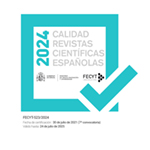Plazas, "ushnus" y experiencias rituales en el valle calchaquí norte durante la ocupación inka
Resumen
En este trabajo discutimos el modo en que los inkas utilizaron la arquitectura de sus asentamientos y la topografía circundante para manipular las experiencias somáticas de quienes participaban en eventos público-ceremoniales. Para ello discutimos la disposición espacial y material de cuatro sitios localizados en el valle Calchaquí Norte (provincia de Salta, Argentina); dos sitios de altura ubicados en la zona de los Nevados de Cachi y dos asentamientos en las áreas septentrional y meridional de esta sección del valle. Nos concentraremos tanto en las estructuras y rasgos presentes en estos cuatro sitios así como en las movilidades y vistas incentivadas por su configuración espacial. Haremos especial énfasis en la accesibilidad visual y física a los espacios de congregación, en las vistas promovidas e inhibidas por su arquitectura, y en la presencia de estructuras y rasgos íntimamente relacionados al ceremonialismo andino como ser plataformas, canales, wank’as, y monolitos. Argumentaremos que las plazas y plataformas de estos asentamientos no solo fomentaban una clara distinción entre representantes del Tawantinsuyu y representantes locales, sino que además dejaban en claro la competencia distintiva y la posición privilegiada que tenían los primeros a la hora de comunicarse con ciertas entidades no humanas del paisaje andino.Descargas
Descarga artículo
Licencia
La Revista Española de Antropología Americana, para fomentar el intercambio global del conocimiento, facilita el acceso sin restricciones a sus contenidos desde el momento de su publicación en la presente edición electrónica, y por eso es una revista de acceso abierto. Los originales publicados en esta revista son propiedad de la Universidad Complutense de Madrid y es obligatorio citar su procedencia en cualquier reproducción total o parcial. Todos los contenidos se distribuyen bajo una licencia de uso y distribución Creative Commons Reconocimiento 4.0 (CC BY 4.0). Esta circunstancia ha de hacerse constar expresamente de esta forma cuando sea necesario. Puede consultar la versión informativa y el texto legal de la licencia.









